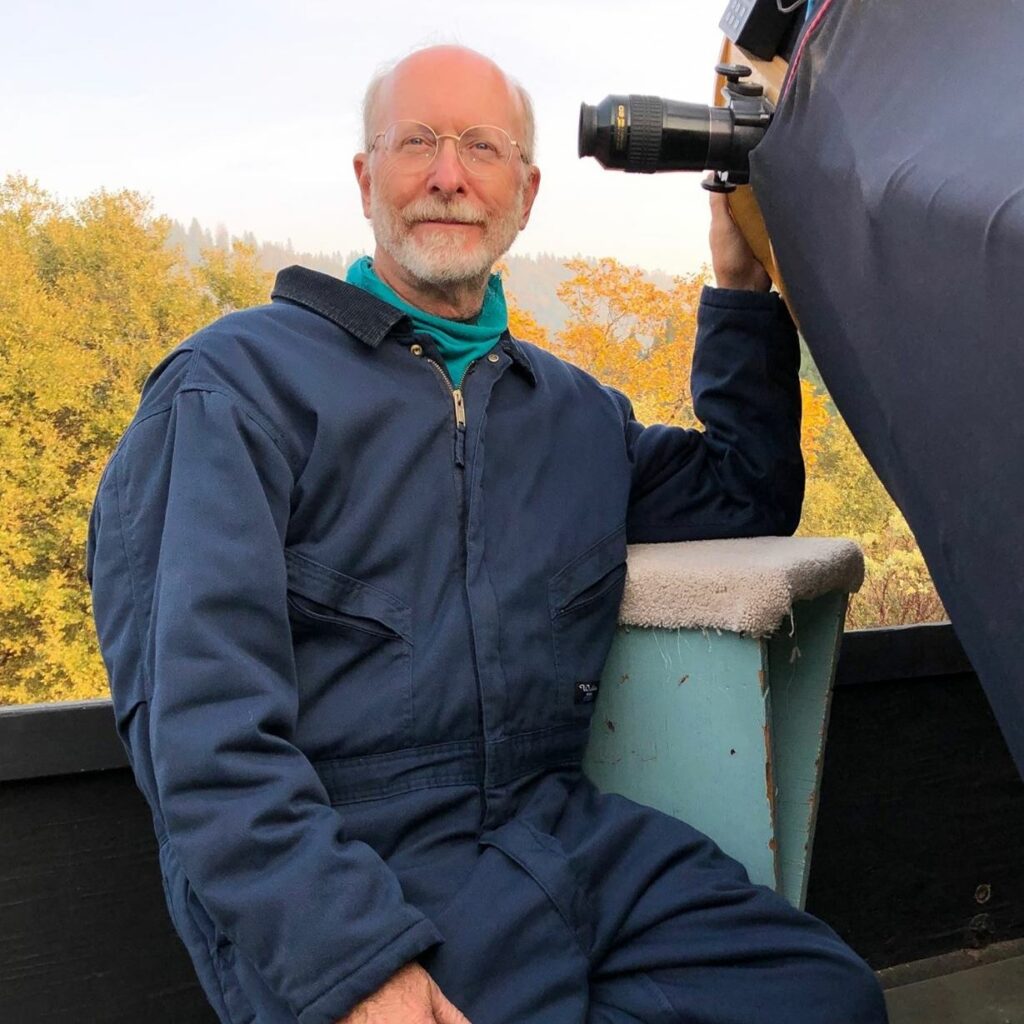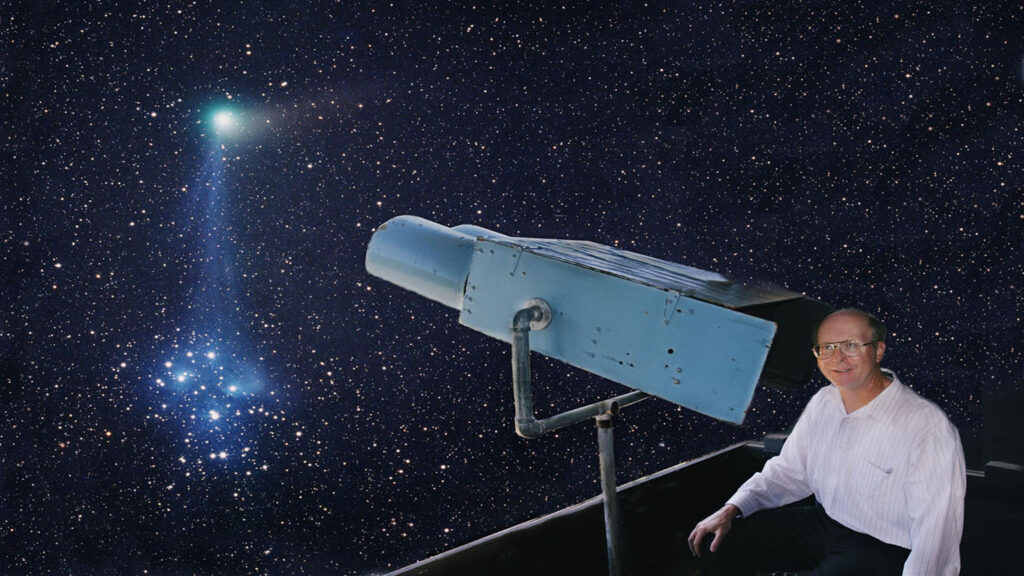The Discovery of Comet Tanaka-Machholz, 1992d
by Don Machholz
Life can pretty much go on without much happening, and then, all in one week, several life-changing, and unrelated events take place.
We moved from San Jose, California, to Colfax in October 1990. Our move, well-planned, was for three reasons. First, we wanted to be able to live on one income so that my wife, Laura, could stay home and take care of the child(ren). Secondly, we wanted to live in a less-crowded and less-congested area, and one without major earthquakes. Thirdly, we wanted to live at a location from which I could hunt for comets from the backyard.
I was hoping that the move to Colfax, with its darker skies, would decrease the amount of time for each discovery from 1000 hours to roughly 300, the average for visual comet discoveries. That move also produced financial strain on our family, as we had to adjust from two large incomes to one small salary. The foothills of the Sierra Nevada range is a beautiful place to live, but not a comfortable place to work. After a short term job at an optical lab in Sacramento, and five weeks of very busy unemployment, I accepted, in March 1991, a manager’s position at Jim Otto’s Burger King Restaurant in Auburn. I quickly moved from Assistant Manager to General Manager, but the pay was neither what I was promised nor what was needed by our family.

By that time, in March 1992, I was living in the largest house that I’ve ever lived in. It sits upon a hilltop, surrounded by our six acres, which we had purchased three years before, while we were still residing in San Jose. Upon moving to Colfax in October 1990, we placed our San Jose home up for sale. It stayed that way for nearly six months, and a couple of price reductions later, it sold. The terms of the deal, which included a balloon payment in the future, were not ideal for us, but we had to get rid of the house. It was then that we could develop our property. This included the installation of a manufactured home on a foundation, hooking up the well, putting in a septic system, and paving the driveway. To save money, we built the garage and deck ourselves. In late September 1991, after living in an apartment in Colfax for the past 11 months, we moved into our new house.
Seeking new comets is a hobby I began in 1975. It branched off of the interest in astronomy dating from 1965 when I received, on my 13th birthday, a two-inch refractor telescope. My first two nights with that scope were disappointing. I almost gave up on the hobby. But viewing Saturn on the evening of October 10 encouraged me to continue using the telescope and learn more about the sky.
To this setting, we add one more element – the adoption of a baby boy. We had adopted Matthew, now just turning six, from South Korea in 1986 at the age of 10 weeks. The process for the second adoption had taken nearly three years; in January 1992 we finally received an assignment of a healthy baby boy, due to arrive at any time.
It was during Matthew’s 6th birthday party that the phone call came. Our new infant son, Mark, would be arriving in two days at the Los Angeles airport. Mark was to arrive on Wednesday, April 1, at 9:30 AM. Our plan was to leave our house late on the night before, drive nonstop to LA, get Mark, then drive back. I had to take the day off from work, not an easy thing to do since the inventory was done the first of each month.
The month of March had only four clear mornings. I had searched for comets on the previous three opportunities, so now, on the morning of March 31, with the skies mostly clear, I decided to comet hunt more of the morning sky. I also realized that being awake at this time of the morning would allow me to be tired enough near the end of the day to get a couple of hours of sleep before leaving for LA. So I got dressed and went out the back door to the deck and the awaiting telescope.
The instrument I used that morning was not my best comet hunting scope. It was designed and constructed in 1989 with the hope that, with it, I could cover a lot of skies and see faint nebulous objects, such as comets. In practice, however, I could not see faint objects, just the bright ones. However, the wide field of view (3.0 degrees) and low power (20.5x) allowed me to sweep the sky rapidly. This telescope was built into a plywood box measuring four feet long, and one foot wide and deep. It was mounted, via pipe fittings, onto the same pipe mount pedestal I’ve used for my other instruments. Using surplus optics, I had built it cheaply, with a final cost of under $150. The primary lens is the same type of 5″ surplus lens that I used for the large binoculars. The eyepiece was a large brass one I bought for $25 at the Riverside Telescope Maker’s Convention in 1987.

The eastern sky was cloudy when I stepped outside at 2:55 AM on the morning of March 31. So I swung the telescope to the northern sky and swept the polar region. An hour later the eastern sky had cleared, I had finished sweeping the polar regions, and I had less than 40 minutes of dark sky left. With no radio on, the scene was quiet, and dew was forming on the deck. So I swung the scope to the eastern sky and began sweeping there for comets.
I made perhaps six sweeps over the next 12 minutes. At 4:07 AM, PST shortly after I began my next sweep, a fuzzy object entered the field that looked awful like a comet. Not only did it not look like a cluster or galaxy, but there were no clusters of galaxies in the area to confuse with comets. So I knew in a second that this was a comet. It had been 760 hours since I had found the previous comet.
My next step was to determine that exact position so that I could report the new object to the Smithsonian Astrophysical Observatory. I took our maps and proceeded to plot its position on the maps. From this, I could measure the coordinates. I then made a large-scale sketch of the comet in reference to the background stars. The comet should show motion in respect to the stars within a half-hour. After a half-hour, I determined that the comet was moving slowly to the NE, at less than one degree per day. I also called my wife out to look at it.
By 6:00 AM I had talked with Dr. Brian Marsden of the Smithsonian Astrophysical Observatory and reported the comet. I then went back to bed, only to be awakened twenty minutes later by a phone call from Dr. Marsden. He wanted to know if I had covered the same area in the previous few days (I hadn’t). He then mentioned that a report of a possible comet had arrived at his office three or four days ago. Apparently, a Japanese amateur astronomer, name Zenicki Tanaka, had reported to the Toyko Observatory that he had photographed a cometary object moving four degrees a day a full week ago. The Toyko Observatory had not followed up on the observation, both because of poor weather, and because the object was reportedly moving so unbelievably fast that it would be hard to locate again. Dr. Marsden mentioned that Tanaka’s position and direction of travel lined up with my position, but the match could only occur if the comet was moving about one degree a day.
The world was to wait until the next day to confirm the motion and existence of the comet. Meanwhile, I had many things to do. After a couple of hours of sleep, I drove to Grass Valley for an interview with Dion Isaacson concerning employment with Little Caesar’s Pizza. After an hour-long interview, I drove to Auburn, to Burger King. Even though it was my day off, I had to complete a few schedules and conduct some of the month-end inventory. Next, it was back to the house to pack for our trip to LA. Following dinner and an hour-long nap, we were up at 11 PM and one our way by 11:30.
Confirming the comet would have been easy from Colfax. But now I was on the road, packing only some maps, a tripod, and 20×80 binoculars. I drove the first leg of the journey while Laura and Matthew slept. By 3:45 AM we had reached Kettleman’s City, along Hwy 5. We pulled a few miles off the freeway and I quickly set up binoculars. Clouds had been moving in and were beginning to cover the part of the sky where the comet was. By the time I had set up, the comet’s position was clouded out and I did not see it.
At Valencia, Ca., we stopped at a Burger King from where I phoned Dr. Marsden. He reported that Alan Hale had observed the comet and that it was moving as I had suggested. More information from Japan revealed that Tanaka had also visually observed the comet of March 24, and seen no apparent motion during 25 minutes of observation. The conclusion was made that the object that he saw was the same object that I had seen. With that, the comet was named Comet Tanaka-Machholz, 1992d. The letter “d” means it was the fourth comet to be recovered or discovered this year.
We continued on to the LA airport, this time with Laura driving. Traffic slowed us for the last 50 miles; we arrived at the airport at 9:05. We went to Terminal #2, this is where the flight was to arrive. We were too late to meet our greeter, he had already gone into customs to help our son and his escort. It was 9:50 when he emerged with our son in arms. Within a half-hour, we left the airport for Manhattan Beach, where we ate a picnic lunch and rested. By noon we were on our way home.

We arrived home at 9:30 PM, and I got some sleep before observing the comet the next morning.
The comet’s path took it northward through the morning sky and under the North Star. In mid-June, it entered the evening sky. It outburst in brightness on May 12, becoming as bright as magnitude 7.0. It was closest to the Sun on April 22 at 1.26 AU, and will never return to the inner Solar System again.
























